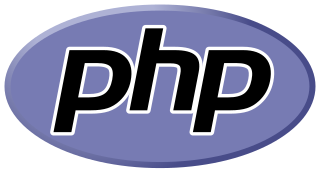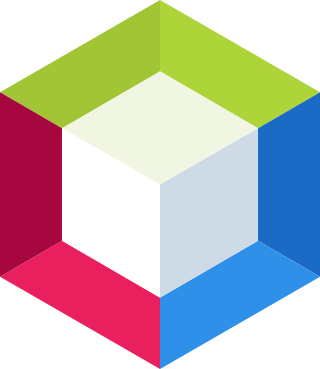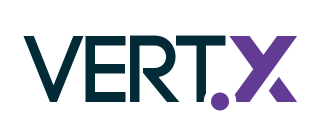
A Java virtual machine (JVM) is a virtual machine that enables a computer to run Java programs as well as programs written in other languages that are also compiled to Java bytecode. The JVM is detailed by a specification that formally describes what is required in a JVM implementation. Having a specification ensures interoperability of Java programs across different implementations so that program authors using the Java Development Kit (JDK) need not worry about idiosyncrasies of the underlying hardware platform.

PHP is a general-purpose scripting language geared towards web development. It was originally created by Danish-Canadian programmer Rasmus Lerdorf in 1993 and released in 1995. The PHP reference implementation is now produced by the PHP Group. PHP was originally an abbreviation of Personal Home Page, but it now stands for the recursive initialism PHP: Hypertext Preprocessor.

NetBeans is an integrated development environment (IDE) for Java. NetBeans allows applications to be developed from a set of modular software components called modules. NetBeans runs on Windows, macOS, Linux and Solaris. In addition to Java development, it has extensions for other languages like PHP, C, C++, HTML5, and JavaScript. Applications based on NetBeans, including the NetBeans IDE, can be extended by third party developers.

Eclipse is an integrated development environment (IDE) used in computer programming. It contains a base workspace and an extensible plug-in system for customizing the environment. It is the second-most-popular IDE for Java development, and, until 2016, was the most popular. Eclipse is written mostly in Java and its primary use is for developing Java applications, but it may also be used to develop applications in other programming languages via plug-ins, including Ada, ABAP, C, C++, C#, Clojure, COBOL, D, Erlang, Fortran, Groovy, Haskell, JavaScript, Julia, Lasso, Lua, NATURAL, Perl, PHP, Prolog, Python, R, Ruby, Rust, Scala, and Scheme. It can also be used to develop documents with LaTeX and packages for the software Mathematica. Development environments include the Eclipse Java development tools (JDT) for Java and Scala, Eclipse CDT for C/C++, and Eclipse PDT for PHP, among others.
Jython is an implementation of the Python programming language designed to run on the Java platform. The implementation was formerly known as JPython until 1999.

Apache Groovy is a Java-syntax-compatible object-oriented programming language for the Java platform. It is both a static and dynamic language with features similar to those of Python, Ruby, and Smalltalk. It can be used as both a programming language and a scripting language for the Java Platform, is compiled to Java virtual machine (JVM) bytecode, and interoperates seamlessly with other Java code and libraries. Groovy uses a curly-bracket syntax similar to Java's. Groovy supports closures, multiline strings, and expressions embedded in strings. Much of Groovy's power lies in its AST transformations, triggered through annotations.
Maven is a build automation tool used primarily for Java projects. Maven can also be used to build and manage projects written in C#, Ruby, Scala, and other languages. The Maven project is hosted by The Apache Software Foundation, where it was formerly part of the Jakarta Project.

Java is a set of computer software and specifications developed by James Gosling at Sun Microsystems that provides a system for developing application software and deploying it in a cross-platform computing environment. Java is used in a wide variety of computing platforms from embedded devices and mobile phones to enterprise servers and supercomputers. Java applets, which are less common than standalone Java applications, were commonly run in secure, sandboxed environments to provide many features of native applications through being embedded in HTML pages.

SlickEdit, previously known as Visual SlickEdit, is a cross-platform commercial source code editor, text editor, and Integrated Development Environment developed by SlickEdit, Inc. SlickEdit has integrated debuggers for GNU C/C++, Java, WinDbg, Clang C/C++ LLDB, Groovy, Google Go, Python, Perl, Ruby, Scala, PHP, Xcode, and Android JVM/NDK. SlickEdit includes such features as built in beautifiers that can beautify code as you type, code navigation, context tagging, symbol references, third party tool integration, DiffZilla, syntax highlighting, and 15 emulations - that include keyboard and selection styles.
The Java Class Loader is a part of the Java Runtime Environment that dynamically loads Java classes into the Java Virtual Machine. Usually classes are only loaded on demand. The virtual machine will only load the class files required for executing the program. The Java run time system does not need to know about files and file systems as this is delegated to the class loader.
Eclipse OpenJ9 is a high performance, scalable, Java virtual machine (JVM) implementation that is fully compliant with the Java Virtual Machine Specification.
Fantom is a general purpose object-oriented programming language created by Brian and Andy Frank that runs on the Java Runtime Environment (JRE), JavaScript, and the .NET Common Language Runtime (CLR). Its primary design goal is to provide a standard library API that abstracts away the question of whether the code will ultimately run on the JRE or CLR. Like C# and Java, Fantom uses a curly brace syntax. The language supports functional programming through closures and concurrency through the Actor model. Fantom takes a "middle of the road" approach to its type system, blending aspects of both static and dynamic typing.

Node.js is a cross-platform, open-source server environment that can run on Windows, Linux, Unix, macOS, and more. Node.js is a back-end JavaScript runtime environment, runs on the V8 JavaScript engine, and executes JavaScript code outside a web browser.

Eclipse Vert.x is a polyglot event-driven application framework that runs on the Java Virtual Machine.

GraalVM is a Java VM and JDK based on HotSpot/OpenJDK, implemented in Java. It supports additional programming languages and execution modes, like ahead-of-time compilation of Java applications for fast startup and low memory footprint. The first production-ready version, GraalVM 19.0, was released in May 2019. The most recent version is GraalVM 23.0.0 , made available in June 2023.
appserver.io is an application server for PHP-based web environments. The project consists of middleware which delivers classical PHP web applications and provides additional services.
Enduro/X is an open-source middleware platform for distributed transaction processing. It is built on proven APIs such as X/Open group's XATMI and XA. The platform is designed for building real-time microservices based applications with a clusterization option. Enduro/X functions as an extended drop-in replacement for Oracle Tuxedo. The platform uses in-memory POSIX Kernel queues which insures high interprocess communication throughput.









